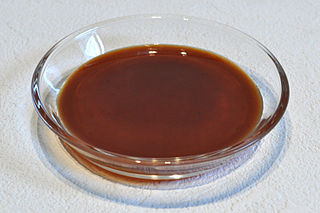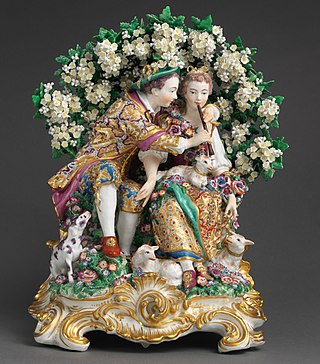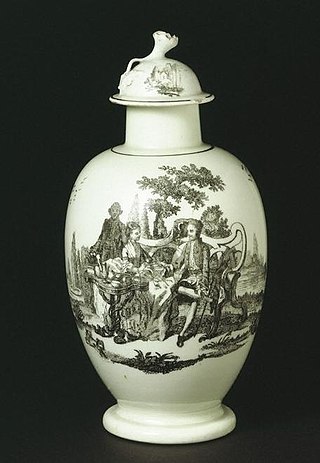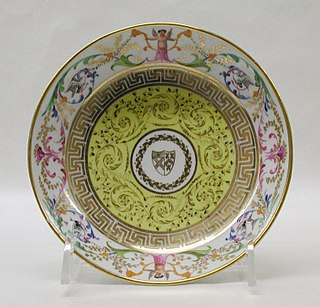
Worcestershire is a ceremonial county in the West Midlands of England. It is bordered by Shropshire, Staffordshire, and the West Midlands county to the north, Warwickshire to the east, Gloucestershire to the south, and Herefordshire to the west. The city of Worcester is the largest settlement and the county town.

Worcestershire sauce or Worcester sauce is a fermented liquid condiment invented by pharmacists John Wheeley Lea and William Henry Perrins in the city of Worcester in Worcestershire, England, during the first half of the 19th century. The inventors went on to form the company Lea & Perrins.

Worcester is a cathedral city in Worcestershire, England, of which it is the county town. It is 30 mi (48 km) south-west of Birmingham, 27 mi (43 km) north of Gloucester and 23 mi (37 km) north-east of Hereford. The population was 103,872 in the 2021 census.

The River Teme rises in Mid Wales, south of Newtown, and flows southeast roughly forming the border between England and Wales for several miles through Knighton before entering England in the vicinity of Bucknell and continuing east to Ludlow in Shropshire. From there, it flows to the north of Tenbury Wells on the Shropshire/Worcestershire border on its way to join the River Severn south of Worcester. The whole of the River Teme was designated as an SSSI by English Nature in 1996.

The Royal Grammar School Worcester is an eleven-eighteen co-educational, private day school and sixth form in Worcester, Worcestershire, England. Founded before 1291, it is one of the oldest British independent day schools.

Benjamin Williams Leader was a British landscape painter.

Malvern Link is an area in the civil parish of Malvern, in the Malvern Hills District, in Worcestershire, England to the north and east of Great Malvern. The centres of Malvern Link and Great Malvern are separated by Link Common, an area of open land that is statutorily protected by the Malvern Hills Conservators. The population of Link ward in 2022 was 6,301.

Chelsea porcelain is the porcelain made by the Chelsea porcelain manufactory, the first important porcelain manufactory in England, established around 1743–45, and operating independently until 1770, when it was merged with Derby porcelain. It made soft-paste porcelain throughout its history, though there were several changes in the "body" material and glaze used. Its wares were aimed at a luxury market, and its site in Chelsea, London, was close to the fashionable Ranelagh Gardens pleasure ground, opened in 1742.

The Royal Crown Derby Porcelain Company is the oldest or second oldest remaining English porcelain manufacturer, based in Derby, England. The company, particularly known for its high-quality bone china, having produced tableware and ornamental items since approximately 1750. It was known as 'Derby Porcelain' until 1773, when it became 'Crown Derby', the 'Royal' being added in 1890.

Charles William Dyson Perrins FRAS was an English businessman, bibliophile, and philanthropist. He was born in Claines, near Worcester, the son of James Dyson Perrins, the owner of the Lea & Perrins Worcestershire sauce factory and the grandson of William Perrins, co-originator of the Lea & Perrins secret recipe.

Royal Worcester is a porcelain brand based in Worcester, England. It was established in 1751 and is believed to be the oldest or second oldest remaining English porcelain brand still in existence today, although this is disputed by Royal Crown Derby, which claims 1750 as its year of establishment. Part of the Portmeirion Group since 2009, Royal Worcester remains in the luxury tableware and giftware market, although production in Worcester itself has ended.

Lea & Perrins (L&P) is a United Kingdom-based subsidiary of Kraft Heinz, originating in Worcester, England where it continues to operate. It is best known as the manufacturer of Lea & Perrins Worcestershire sauce, a condiment first invented and sold in 1837 by chemists John Wheeley Lea and William Henry Perrins from Broad Street, Worcester.

Hartlebury Castle, a Grade I listed building, near Hartlebury in Worcestershire, central England, was built in the mid-13th century as a fortified manor house, on manorial land earlier given to the Bishop of Worcester by King Burgred of Mercia. It lies near Stourport-on-Severn in an area with several large manors and country houses, including Witley Court, Astley Hall, Pool House, Areley Hall and Hartlebury and Abberley Hall. Later, it became the bishop's principal residence.

Great Malvern railway station is one of two stations serving the town of Malvern, Worcestershire, England on the Hereford to Worcester section of the Cotswold Line. It is situated downhill from the centre of Great Malvern and close to Barnards Green. The station retains most of its original Victorian station design by the architect Edmund Wallace Elmslie and is a Grade II listed building.

Henry George Sandon was an English antiques expert, television personality, author and lecturer who specialised in ceramics and was a notable authority on Royal Worcester porcelain. He was the curator of the Dyson Perrins Museum for many years.

Thomas Baxter Jnr. was an English porcelain painter, and a watercolour painter and illustrator.

John Wall, was an English physician, one of the founders of the Worcester Royal Infirmary and the Royal Worcester porcelain works. He was also involved in the development of Malvern as a spa town.

Fownes Hotel and Restaurant is a hotel in Worcester, England, along the canalside. It is situated in an old Victorian glove factory. It has 63 rooms. The three-storey red brick building, with twenty-five bays, dates to 1882–4, when it was built by Yeates & Jones, 1882–4. It was later extended. It is described as having a "classic English restaurant, where meals are served on Royal Worcester porcelain".

Worcester's early importance is partly due to its position on trade routes, but also because it was a centre of Church learning and wealth, due to the very large possessions of the See and Priory accumulated in the Anglo-Saxon period. After the reformation, Worcester continued as a centre of learning, with two early grammar schools with strong links to Oxford University.




















